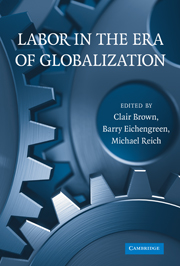Book contents
- Frontmatter
- Contents
- Tables and Figures
- List of Authors and Editors
- Introduction: Labor in the Era of Globalization
- PART ONE POLITICAL ECONOMY AND LABOR MARKET INSTITUTIONS
- PART TWO INSTITUTIONS AND FIRM AND WORKER BEHAVIOR
- PART THREE CONTEMPORARY LABOR–MANAGEMENT RELATIONS
- PART FOUR PUBLIC POLICY AND U.S. LABOR-MARKET STRUCTURE
- 11 Minimum Wages in the United States: Politics, Economics, and Econometrics
- 12 The Causes and Labor-Market Consequences of the Steep Increase in U.S. Incarceration Rates
- 13 Local Labor-Market Adaptation to Increased Immigration
- Index
- References
13 - Local Labor-Market Adaptation to Increased Immigration
Published online by Cambridge University Press: 05 June 2012
- Frontmatter
- Contents
- Tables and Figures
- List of Authors and Editors
- Introduction: Labor in the Era of Globalization
- PART ONE POLITICAL ECONOMY AND LABOR MARKET INSTITUTIONS
- PART TWO INSTITUTIONS AND FIRM AND WORKER BEHAVIOR
- PART THREE CONTEMPORARY LABOR–MANAGEMENT RELATIONS
- PART FOUR PUBLIC POLICY AND U.S. LABOR-MARKET STRUCTURE
- 11 Minimum Wages in the United States: Politics, Economics, and Econometrics
- 12 The Causes and Labor-Market Consequences of the Steep Increase in U.S. Incarceration Rates
- 13 Local Labor-Market Adaptation to Increased Immigration
- Index
- References
Summary
INTRODUCTION
The United States is once again becoming a country of immigrants. Immigrant arrivals – currently more than one million people per year – now account for approximately 40 percent of population growth. The effects of these inflows are controversial, in part because of their sheer size and in part because of their composition. Roughly one third of new arrivals are undocumented immigrants from Mexico and Central America who have low education and limited English skills (Passel 2005). Although another quarter of immigrants – from countries such as India and China – are relatively skilled, critics of current policy often emphasize the presumed negative effects of lower-skilled immigration on the labor-market opportunities of less-skilled natives (Borjas 1999).
Immigration is a particular concern in the nation's largest cities, where most immigrants live. Among the 100 largest Primary Metropolitan Statistical Areas (PMSAs) in the 2000 Census, for example, 18.7 percent of people ages sixteen to sixty-five were immigrants – substantially above the share in the nation as a whole. Even among large cities, there is wide variation in the share of immigrants in the local population. Immigrants comprise more than 40 percent of the working-age population in Los Angeles and New York but less than 10 percent in Philadelphia and Detroit. This remarkable heterogeneity raises an important question: How do local labor markets in high-impact cities adapt to the presence of large numbers of immigrants?
- Type
- Chapter
- Information
- Labor in the Era of Globalization , pp. 414 - 444Publisher: Cambridge University PressPrint publication year: 2009



